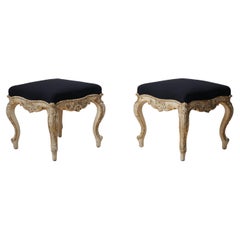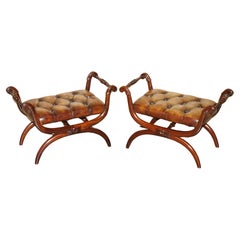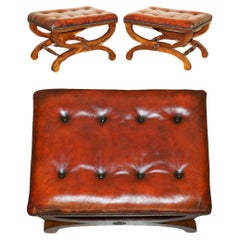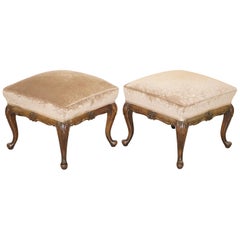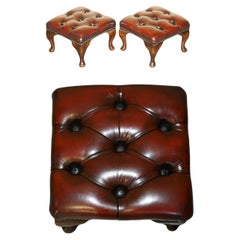Pair Antique Footstools
to
17
50
47
98
1
23
5
4
4
4
3
1
1
1
5
54
38
1
17
12
5
1
3
2
1
1
70
30
23
23
22
78
39
29
25
5
97
97
97
13
1
1
1
1
Sort By
Pair Antique Footstools or Benches
Located in New York, NY
Pair antique footstools or benches on casters with floral upholstery. Good condition overall with
Category
Early 20th Century North American American Classical Benches
Materials
Hardwood
Antique Swedish Pair of Large Rococo Style Footstools
Located in Kramfors, SE
Pair of large upholstered stools in rococo style made during the rococo revival in the late 19th
Category
Antique Late 19th Century Swedish Rococo Revival Footstools
Materials
Pine
PAIR OF ANTIQUE BROWN LEATHER CHESTERFIELD TUFTED REGENCY FRAMED FOOTSTOOLs
By Chesterfield
Located in West Sussex, Pulborough
Royal House Antiques
Royal House Antiques is delighted to offer for sale this stunning pair of
Category
Antique Early 1900s English Edwardian Footstools
Materials
Leather, Hardwood
$3,645 Sale Price / set
20% Off
H 21.66 in W 31.5 in D 16.15 in
PAIR OF ANTIQUE REGENCY BROWN LEATHER CHESTERFIELD BARON X FRAMED FOOTSTOOLs
By Chesterfield
Located in West Sussex, Pulborough
Royal House Antiques
Royal House Antiques is delighted to offer for sale this stunning pair of
Category
Antique Early 1900s English Edwardian Footstools
Materials
Leather, Hardwood
$3,725 Sale Price / set
20% Off
H 17.13 in W 25.2 in D 18.9 in
SUBLIME PAiR OF ANTIQUE VICTORIAN CLAW & BALL HARDWOOD FRAMED SMALL FOOTSTOOLS
Located in West Sussex, Pulborough
Royal House Antiques
Royal House Antiques is delighted to offer for sale this exquisite pair of
Category
Antique 19th Century English Victorian Footstools
Materials
Upholstery, Hardwood
$2,613 Sale Price / set
20% Off
H 11.03 in W 15.16 in D 11.03 in
Sublime Pair of circa 1860 Antique Victorian Footstools Stools Carved Hardwood
Located in West Sussex, Pulborough
mahogany footstool stools
These are a very high end luxurious pair of stools, they have been inspired by
Category
Antique 1860s English Early Victorian Footstools
Materials
Upholstery, Hardwood
$2,168 Sale Price / set
20% Off
H 18.12 in W 20.08 in D 20.08 in
LOVELY PAIR OF GREY FABRIC STUDDED FOOTSTOOLS SiDE STAND STOOL
Located in Pulborough, GB
Antiques of London
We are delighted to offer for sale this Lovely Pair of Grey Fabric Studded
Category
20th Century British Footstools
Materials
Fabric
$625 / set
H 16.54 in W 16.54 in D 16.54 in
PAIR OF RESTORED BROWN LEATHER CHESTERFIELD TUFTED PORCELAIN CASTORS FOOTSTOOLs
Located in West Sussex, Pulborough
Royal House Antiques is delighted to offer for sale this absolutely exquisite pair of fully
Category
Vintage 1940s British High Victorian Footstools
Materials
Leather, Porcelain, Oak
$3,280 Sale Price
20% Off
H 12.21 in W 24.41 in D 17.33 in
PAIR OF VINTAGE CHESTERFIELD TUFTED WINGBACK ARMCHAIR OXBLOOD LEATHER FOOTSTOOLs
By Chesterfield
Located in West Sussex, Pulborough
Royal House Antiques
Royal House Antiques is delighted to offer for sale this stunning pair of
Category
Antique Early 1900s English Edwardian Footstools
Materials
Leather, Hardwood
$2,635 Sale Price / set
20% Off
H 9.06 in W 12.6 in D 12.6 in
PAIR OF RESTORED CLAW & BALL VINTAGE HAND DYED LEATHER CHESTERFIELD FOOTSTOOLs
By Chesterfield
Located in West Sussex, Pulborough
pair of fully restored, hand dyed leather, Chesterfield Tufted footstools with ornately carved Claw
Category
Early 20th Century English Art Deco Footstools
Materials
Leather
$3,855 / set
H 13 in W 27.56 in D 17.72 in
PAiR OF FULLY RESTORED VINTAGE HAND DYED BROWN LEATHER CHESTERFIELD FOOTSTOOLS
By Chesterfield
Located in West Sussex, Pulborough
pair of fully restored, hand dyed Cigar brown leather, Chesterfield Tufted Baron footstools
Please
Category
Early 20th Century English Art Deco Footstools
Materials
Leather, Hardwood
$3,308 Sale Price / set
20% Off
H 14.18 in W 23.63 in D 16.54 in
FINE PAIR OF ORNATE HAND CARVED VICTORIAN BROWN LEATHER CHESTERFIELD FOOTSTOOLs
By Chesterfield
Located in West Sussex, Pulborough
Royal House Antiques
Royal House Antiques is delighted to offer for sale this stunning pair of
Category
Antique 1880s English Victorian Footstools
Materials
Leather, Hardwood
$3,084 Sale Price / set
20% Off
H 7.88 in W 14.38 in D 9.85 in
Pair of English Regency 19th Century Footstools with Carved Feet and Gilt Trim
Located in Atlanta, GA
A pair of English Regency period footstools from the 19th century with carved feet, gilded accents
Category
Antique 19th Century English Regency Footstools
Materials
Wood
$6,750 / set
H 11 in W 13 in D 13 in
Pair of Antique X-Form Stools Reinterpreted in Lacquer
Located in Bridgeport, CT
Fine diminutive footstool pair of neoclassical style footstools in custom lacquer and upholstery
Category
Antique 19th Century Mid-Century Modern Footstools
Materials
Walnut
Fine Pair of Georgian Style Antique Carved Walnut Benches
Located in Bridgeport, CT
The pair in a handsome deep amber tone walnut with good graining. Rounded rectangular benches
Category
Antique 19th Century Georgian Footstools
Materials
Walnut
Pair of Italian Pale Green Stools
Located in Dallas, TX
Good pair of antique Italian pale green paint stools. Circa 1890. Perfect for today's transitional
Category
Antique 1890s Footstools
Materials
Fabric, Wood
Pair Of Antique Footstools, English, Walnut, Cushioned Stool, Early Victorian
Located in Hele, Devon, GB
This is a pair of antique footstools. An English, walnut and boxwood cushioned stool, dating to the
Category
Antique Mid-19th Century British Victorian Furniture
Materials
Boxwood, Walnut
$1,681
H 4.34 in W 10.63 in D 10.63 in
PAIR OF CHESTERFIELD VINTAGE OXBLOOD LEATHER WINGBACK ARMCHAIRS & FOOTSTOOLs
By Chesterfield
Located in West Sussex, Pulborough
exquisite pair of fully restored Wingback armchairs with hand carved frames and matching footstools in
Category
Early 20th Century English Chesterfield Wingback Chairs
Materials
Leather
$13,460 Sale Price / set
20% Off
H 45.28 in W 34.85 in D 34.26 in
PAIR OF COLLECTABLE LIBERTY'S OMERSA BROWN LEATHER HiPPOPOTAMUS FOOTSTOOL HIPPO
By Liberty of London
Located in West Sussex, Pulborough
Royal House Antiques
Royal House Antiques is delighted to offer for sale this absolutely sublime
Category
Vintage 1940s European Art Deco Animal Sculptures
Materials
Leather
$1,626 Sale Price / set
20% Off
H 3.75 in W 12.21 in D 5.91 in
FINE PAIR OF CHESTERFIELD CHESTNUT BROWN LEATHER WINGBACK ARMCHAIRS & FOOTSTOOLs
By Chesterfield
Located in West Sussex, Pulborough
exquisite pair of fully restored Wingback armchairs with matching footstools in Chestnut Brown which are
Category
Early 20th Century English Chesterfield Wingback Chairs
Materials
Leather
$8,917 Sale Price / set
20% Off
H 45.67 in W 33.08 in D 35.83 in
PAIR OF VINTAGE TAN BROWN LEATHER CHESTERFiELD WINGBACK CHAIRS WITH FOOTSTOOLS
By Chesterfield
Located in West Sussex, Pulborough
Royal House Antiques
Royal House Antiques is delighted to offer for sale this stunning, lightly
Category
20th Century English Chesterfield Wingback Chairs
Materials
Leather
$7,795 Sale Price / set
20% Off
H 43.51 in W 30.52 in D 36.42 in
Pair of Italian Golden Footstools, 20th Century
Located in London, GB
A beautiful pair of Italian golden footstools.
Pair of Italian footstools from the mid-20th
Category
Mid-20th Century Italian Footstools
Materials
Fabric, Wood
Pair of antique stools
Located in Sag Harbor, NY
Antique foot stools recovered in faux zebra fabric with mahogany legs. May be sold separately.
Category
Antique 19th Century American Footstools
Materials
Mahogany
Pair of Swedish antique stools
Located in Ramatuelle, PACA
Elegant Swedish stools in their original grey white patina. To be reuphoistered
Category
Antique 18th Century and Earlier Swedish Footstools
Materials
Wood
Pair of Antique Footstools
Located in East Hampton, NY
Great pair of antique footstools newly upholstered in dark brown linen with cream tape
Category
Antique 19th Century American Footstools
Materials
Linen, Wood
Pair Antique French Regence Footstools
Located in Dallas, TX
Sold as a pair, hand-carved from solid French fruitwood with very recent upholstery.
Category
Early 20th Century French Régence Footstools
Pair of Antique Walnut Claw and Ball Footstools
Located in Chelmsford, Essex
Pair of antique walnut claw and ball hand dyed leather stools in very good condition having been
Category
Antique 1890s Late Victorian Footstools
Materials
Walnut
Pair of Antique Walnut Claw and Ball Footstools
Located in Chelmsford, Essex
Pair of antique walnut claw and ball hand dyed leather stools in very good condition having been
Category
Antique 1890s Late Victorian Footstools
Materials
Walnut
An Honest Pair of Antique English Ladies Beaded Footstools
Located in Chicago, IL
A rare find. An actual pair of footstools. Most pairs of anything usually are separated over the
Category
Antique 19th Century British Victorian Footstools
Materials
Velvet
PAIR OF ANTiQUE VICTORIAN KILIM UPHOLSTERED WINGBACK ARMCHAIR FOOTSTOOLS
Located in West Sussex, Pulborough
Royal House Antiques
Royal House Antiques is delighted to offer for sale this exquisite pair of
Category
Antique 19th Century English Kilim Footstools
Materials
Upholstery
$2,710 / set
H 9.65 in W 13.59 in D 10.24 in
Antique Pair of Regency Hardwood Round Footstools Silk Embroidered Upholstery
Located in West Sussex, Pulborough
We are delighted to offer this very nice early pair of Regency Rosewood footstools with silk
Category
Antique 19th Century English Regency Footstools
Materials
Silk, Hardwood
$1,876 / set
H 7.49 in Dm 13.59 in
Pair of French Antique Louis XVI Style Footstools in Beechwood
Located in Round Top, TX
Pair of early 20th century French antique Louis XVI style benches / ottomans in beechwood. Priced
Category
20th Century French Footstools
Materials
Beech
PAIR OF REGENCY BLUE ANTIQUE ViCTORIAN CHESTERFIELD TUFTED CURVED FOOTSTOOLS
By Chesterfield
Located in West Sussex, Pulborough
Royal House Antiques
Royal House Antiques is delighted to offer for sale this stunning pair of
Category
Antique 19th Century English Late Victorian Footstools
Materials
Velvet, Mahogany
$2,057 / set
H 8.08 in W 10.83 in D 13.59 in
Antique Jacobean Turn Carved Walnut Handmade Cane Seat Footstool Ottoman - Pair
Located in Philadelphia, PA
Antique Jacobean Turn Carved Spiral Twist Walnut Handmade Cane Seat Footstool Ottoman - Pair. Item
Category
Antique 19th Century Jacobean Footstools
Materials
Walnut
$1,395 / set
H 11.5 in W 17.25 in D 12.25 in
Pair of French Antique Footstools in Golden Wood from 19th Century
Located in Vicoforte, Piedmont
Pair of French footstools from the late 19th century. Furniture in richly carved and gilded wood of
Category
Antique Late 19th Century French Footstools
Materials
Fabric, Wood
$1,750
H 6.7 in W 14.97 in D 14.97 in
Pair of Antique Hardwood Lion Hairy Paw Feet Footstools for Wingback Armchairs
Located in West Sussex, Pulborough
We are delighted to offer for sale this exquisite pair of Victorian mahogany small footstools with
Category
Antique 19th Century English Victorian Footstools
Materials
Upholstery, Hardwood
$4,100 / set
H 7.49 in W 13 in D 11.42 in
Pair of Antique Hardwood William IV circa 1830 Footstools Mulberry Flying Ducks
By Mulberry
Located in West Sussex, Pulborough
We are delighted to offer lovely pair of original Mahogany William IV circa 1830 footstools newly
Category
Antique 1830s English William IV Footstools
Materials
Upholstery, Hardwood
$4,100 / set
H 17.52 in W 16.74 in D 16.54 in
Pair of 19th Century Victorian Walnut Leather Footstools
Located in Chelmsford, Essex
Pair of Victorian walnut footstools that have been upholstered in antique brown leather, deep
Category
Antique Mid-19th Century European Late Victorian Footstools
Materials
Walnut
PAIR OF RESTORED CHESTERFIELD FOOTSTOOL OTTOMANS IN RiCH HAND DYED BROWN LEATHER
By Chesterfield
Located in West Sussex, Pulborough
pair of original circa 1930's Art Deco, super comfortable hand dyed saddle brown leather footstools
Category
Vintage 1930s English Art Deco Footstools
Materials
Leather, Hardwood
$3,266 / set
H 21.07 in W 26.78 in D 16.93 in
Pair of Terrance Conran Fully Restored Hand Dyed Brown Leather Cube Footstools
By Sir Terence Conran
Located in West Sussex, Pulborough
footstools
A good looking and well made pair which have been hand dyed six times, antiqued and sealed by
Category
20th Century English Mid-Century Modern Footstools
Materials
Leather
$2,085 / set
H 15.56 in W 15.56 in L 15.56 in
Pair of French Louis XVI Carved Painted Oval Footstools with Blue Velvet Fabric
Located in Dallas, TX
Elegant pair of antique footstools from Paris, France; crafted circa 1870, each oval stool features
Category
Antique Late 19th Century French Louis XVI Footstools
Materials
Velvet, Beech
$1,600
H 7 in W 14 in D 11 in
Pair of Early 20th Century French Louis XVI Carved Painted and Gilt Footstools
Located in Dallas, TX
Elevate your feet while sitting in your favourite armchair with this elegant pair of antique
Category
Early 20th Century French Louis XVI Footstools
Materials
Silk, Beech
$1,200 / set
H 12.5 in Dm 16.5 in
Pair of Antique Spanish Benches In Walnut
Located in Round Top, TX
Pair of late 19th century Spanish upholstered benches with arms. (Priced per bench.)
Keywords
Category
Antique 19th Century Spanish Footstools
Materials
Walnut
Pair of Antique French Carved Walnut Foot Stools
Located in London, GB
A beautiful pair of small oval antique French style foot stools, which I would date from around the
Category
Early 20th Century French Louis XV Footstools
Materials
Walnut
Pair of Antique French Carved Walnut Foot Stools
Located in London, GB
A beautiful pair of small oval antique French style foot stools, which I would date from around the
Category
Early 20th Century French Louis XV Footstools
Materials
Walnut, Fabric
Pair of Antique French Carved Walnut & Needlepoint Tapestry Foot Stools
Located in Big Flats, NY
Pair of Antique French footstools feature carved walnut frames having cabriole legs with carved
Category
Antique 19th Century French Footstools
Materials
Upholstery, Walnut
$715 / set
H 13 in W 20.5 in D 14 in
Pair of French Antique Louis XIII Style Foot Stools
Located in Round Top, TX
Pair of French Antique Louis XIII Style Foot Stools in Walnut. Price listed is for the pair.
Category
Antique 19th Century French Footstools
Materials
Walnut
Pair Antique English Victorian Needlepoint Foot Rest circa 1870
Located in New Orleans, LA
Pair of Antique English Victorian Needlepoint Foot Rests circa 1870
Category
Antique 1870s English Footstools
Materials
Fabric
$6,150 / set
H 13.5 in W 17 in D 16.5 in
Pair, Antique Empire Style White Painted Stools from Sweden
Located in Round Top, TX
This romantic pair of Empire style white painted wooden Curule stools are from Sweden, mid-19th
Category
Antique Mid-19th Century Swedish Footstools
Materials
Wood, Paint
Pair of Antique Rococo Giltwood Stools W 18th C Aubusson Tapestry
Located in LOS ANGELES, CA
Pair of Antique Rococo Giltwood Stools W 18th C Aubusson Tapestry
Category
Antique 18th Century French Rococo Footstools
Materials
Tapestry, Giltwood
Pair of Antique Foot Stools English Victorian Needlepoint Carriage, circa 1860
Located in Hele, Devon, GB
Our Stock # LFA-1531
This is a pair of antique foot stools, English, Victorian, needlepoint
Category
Antique Mid-19th Century English Victorian Footstools
Materials
Tapestry, Walnut
$688
H 6.5 in W 12.01 in D 12.01 in
Antique Pair of Walnut Foot Stools with 18th Century Aubusson Tapestry
Located in Dallas, TX
Pair of 19th century Louis XIV walnut foot stools reupholstered with 18th century Aubusson
Category
Antique Late 19th Century French Louis XIV Footstools
$1,600
H 6.5 in W 14 in D 10 in
Pair of Antique White Painted Louis XVI Style Ottomans Benches Stools circa 1950
Located in Swedesboro, NJ
This is a beautiful pair of Maison Jansen style stools in good condition. They each measure 25 wide
Category
Vintage 1950s American Louis XVI Footstools
Materials
Walnut
$1,850 / set
H 17 in W 25 in D 17 in
Pair of French Napoleon III Period Stools
Located in Austin, TX
Darling pair of antique French Napoleon III period hand carved and gold leafed stools with patined
Category
Antique 19th Century French Footstools
Pair 19th Century Victorian Walnut Leather Hand Dyed Foot Stools
Located in Chelmsford, Essex
Pair of Victorian footstools that have been upholstered in antique brown leather, deep buttoned and
Category
Antique Mid-19th Century English Late Victorian Footstools
Materials
Walnut, Leather
Pair of Louis XV period Walnut Stools, c. 1760
Located in Atlanta, GA
A pair of Louis XV stools, constructed in walnut with carved designs and leather upholstery of a
Category
Antique 18th Century and Earlier French Footstools
Pair of Swedish Painted Wood and Upholstered 19th Century Karl Johan Stools
Located in Atlanta, GA
A pair of Swedish 19th century stools. This antique pair of petite wooden benches (or footstools
Category
Antique 19th Century Swedish Karl Johan Footstools
Materials
Wood, Upholstery
$3,370 / set
H 22.75 in W 25 in D 14.25 in
Pair of Midcentury Franco Albini Style Bamboo Stools, 1960s, Italy
By Franco Albini
Located in Biebergemund, Hessen
Pair of very decorative bamboo stools from 1960s, Italy in the style of Franco Albini. It consists
Category
Mid-20th Century Italian Mid-Century Modern Footstools
Materials
Bamboo
$1,082 / set
H 14.57 in Dm 17.72 in
- 1
Get Updated with New Arrivals
Save "Pair Antique Footstools", and we’ll notify you when there are new listings in this category.
Pair Antique Footstools For Sale on 1stDibs
Find a variety of pair antique footstools available on 1stDibs. Frequently made of wood, walnut and fabric, all pair antique footstools available were constructed with great care. Pair antique footstools have been made for many years, and versions that date back to the 18th Century alongside those produced as recently as the 20th Century. Pair antique footstools bearing Victorian or Louis XVI hallmarks are very popular at 1stDibs.
How Much are Pair Antique Footstools?
Prices for pair antique footstools can differ depending upon size, time period and other attributes — at 1stDibs, pair antique footstools begin at $350 and can go as high as $3,250, while the average can fetch as much as $1,437.

